Disclosure: Meeple Mountain received a free copy of this product in exchange for an honest, unbiased review. This review is not intended to be an endorsement.
Seattle is a town that knows its fish. Whether you’re slammin’ salmon at the Ballard Seafood Fest, chowing down on clam chowder at your favorite Ivar’s location, or just checking out the crab boats that line Salmon Bay, the town by the Sound is a hub for all things piscine. And there’s no seafood store more iconic than Pike Place Fish Market, the infamous stand where the fishmongers throw the customers’ orders across the length of the storefront while tourists cheer.
That makes Seattle the perfect setting for Talon Strikes Studios’ latest offering, Public Market. This medium-heavy title has players navigating a variable turn order, collecting sets, and placing polyominoes in their quest to be the most successful sailor and salesperson.
I’m Sailing Away
Back when I mentioned Public Market in our 2020 preview, I said that the cover art was so beautiful that I’d be willing to buy an empty box just for the lid. While the cover is by far the largest and most luscious piece, the illustrations throughout this game are delightful.
Cool blue tones line up against gingham-checked card backs. Chalk-white line drawings that look like they were pulled from a natural history museum somehow mesh with pleasantly plump and mostly realistic fish. The overall feeling is a sort of non-specific nostalgia, a sense that the game is capturing an idealized timeless moment in a Seattle that never really was. Because the art style is so fitting, I found myself occasionally wishing there was just a little bit more of it to gaze at. That’s not a criticism; it’s just hard to get enough of two great artists like Beth Sobel and Jason Washburn.
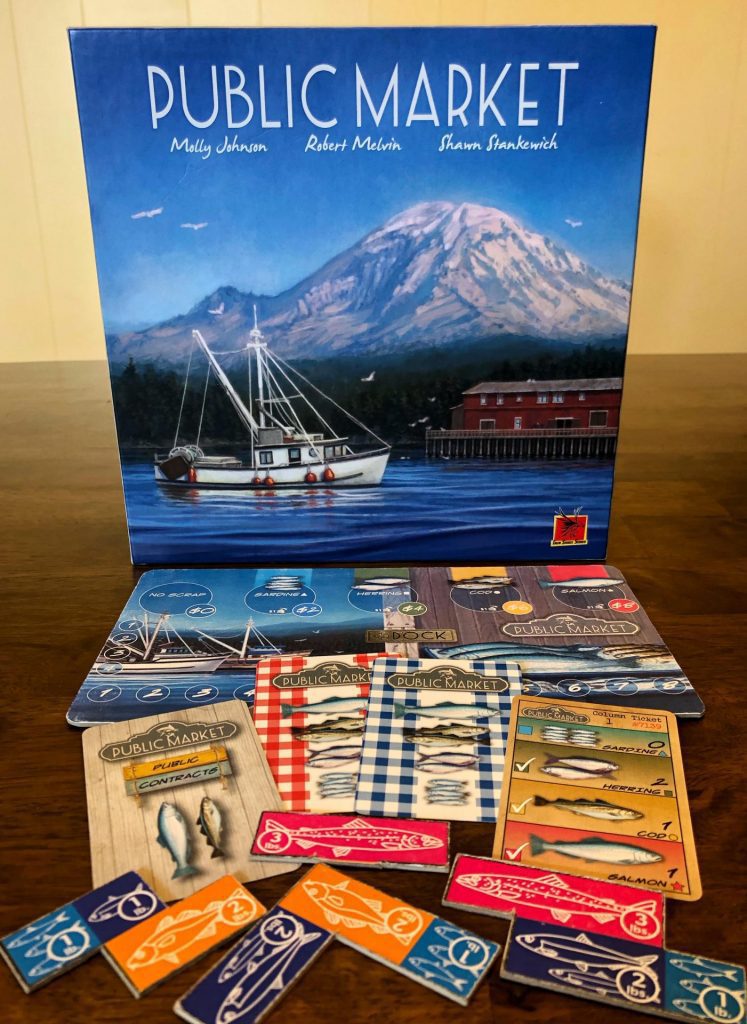
But once the game starts, you won’t be able to even think about the art because there’s a lot going on in Public Market. That’s clear from the moment a player sits down and receives, in no particular order: a player board, a worker meeple in their player color, 8 matching cubes, 4 purple gears, 6 red crab meeples, 4 white fish meeples, $12 in coin tokens, and an ice chest card. That’s at least 23 bits and two boards — per player — before the first turn even starts.
It seems daunting at first, but take a deep breath of salt air and steady your sea legs because the core gameplay is actually quite simple and familiar. In each round, players assign their single worker to one of 5 slots, paying a set cost and getting a fish for their trouble. The more expensive the slot the better the rewards, with each slot offering a progressively more valuable fish and a higher turn order.

Once all the players have picked a slot, they’ll choose — in their newly determined turn order — whether to go fishing or take their haul to market. Fishing means taking one of a select few polyominoes and fitting it onto the player’s ice chest board, trying to maximize efficiency while being mindful of a few special bonuses available for clever placement. Going to market means using fish from the player’s ice chest to fill contracts that offer rewards for specific numbers and combinations of the four available fish breeds.
Once everyone has fished or sold, there’s a little bit of cleanup and then it’s time for a new round. Easy, right?
Fish is Brain Food
Okay, I lied: Public Market isn’t really easy at all. Each of the above steps is actually a net of complex decisions and making the right choice at the right time is rarely straightforward.

Take the first phase: selecting turn order. Assigning your single worker to a higher slot means getting a more valuable fish and a better turn order, so that’s a no-brainer. Except that the highest slot costs a substantial $8, which eats into your profit margins pretty quickly. Maybe it’s better to pick a lower slot and hope that the other players leave something good behind for you…but what if they don’t?
To complicate things further, unlike in most worker placement games these slots aren’t exclusive. Another player can assign their worker to the same slot, choosing either to go after the player already there or to go just before them by paying them a single dollar. And while you’re mulling that possibility over, consider the fact that if you just want the turn order but don’t need that particular fish, then you can pick up a fish from a lower slot. This can be valuable if you want to edge out your competitors but don’t have space for, say, a big hunk of salmon.
All of these things combine to make even the very first step of the very first turn surprisingly complex. Before anyone’s even done anything, Public Market is sinking its hooks into you, making you think and rethink your options. There’s a constant calculator clacking away in the back of your head from the moment you start, always trying to figure out just how important any one thing is at any given moment and whether the reward is worth the risk.
Fish Out of Water
Let’s say you manage to sail through turn order selection. Next, each player will decide whether to fish or go to market; they’ll immediately and completely resolve that decision before the next player acts.

To fish, the player will select one of the handful of oddly-shaped polyominoes underneath the boat — in this harbor, all the sailors share a single vessel — and add it to their ice chest. The polyominoes comprise multiple “blocks” of different fish, so you want to pick the combination that suits your needs.
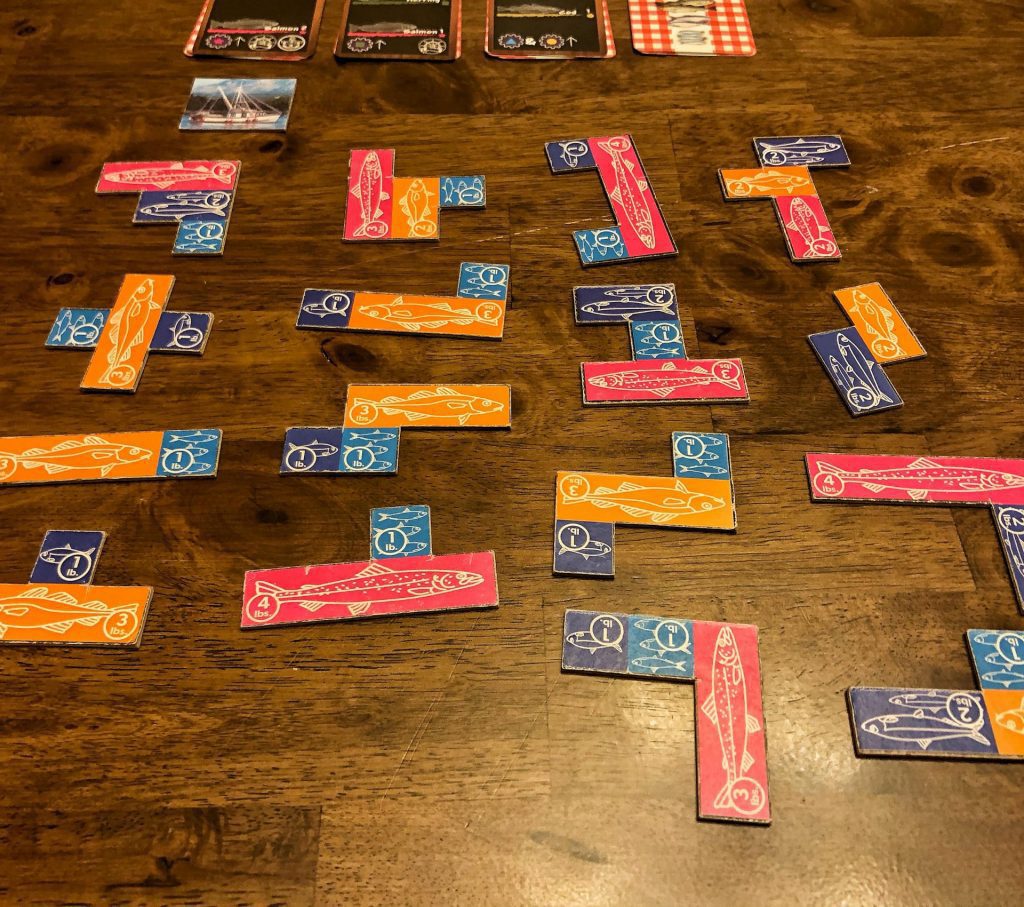
At the same time you’ll want to make sure it fits in your ice chest because anything that doesn’t fit you have to sell on the spot for a mere $3. Packing your catch is made more difficult by the ice blocks, spaces which can’t be used at all. Oh, and remember that you still need to account for the fish you picked up earlier this turn, to say nothing of what’s already in the chest.
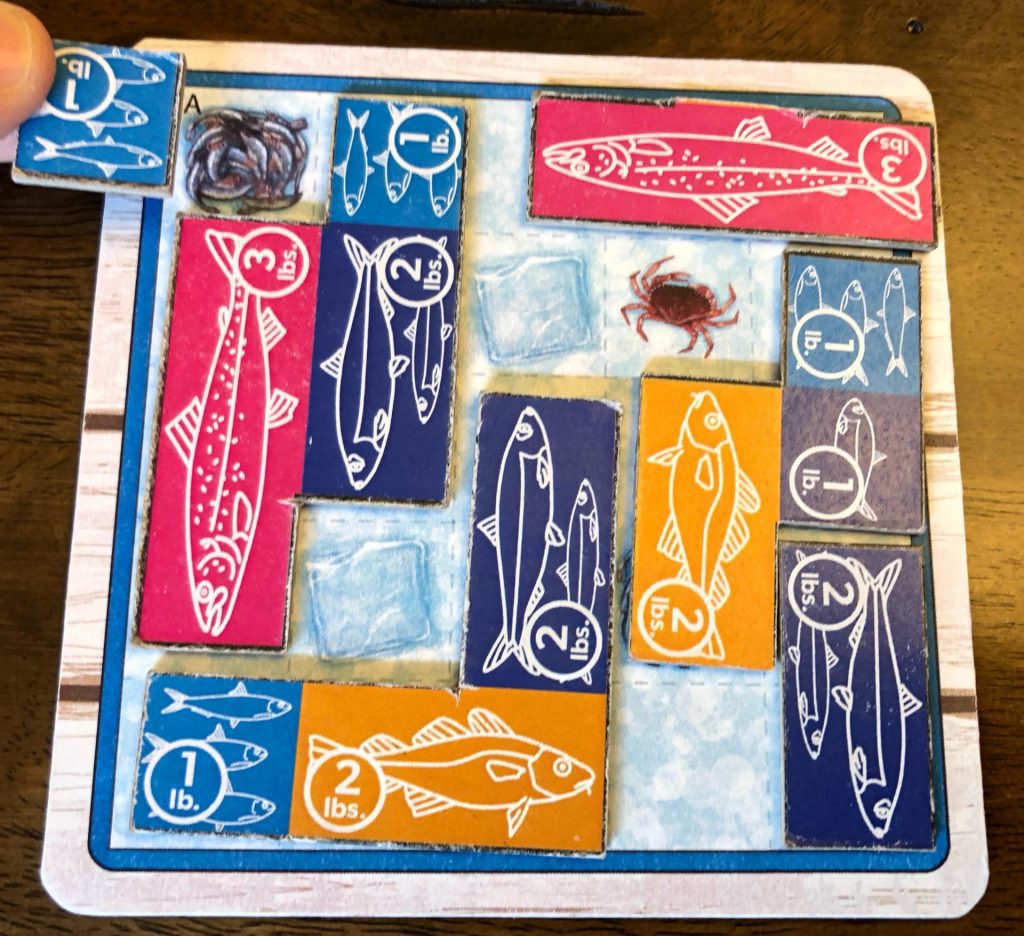
Then there are the shrimp and crab spaces, which add another tricky wrinkle. Covering all 3 shrimp spaces in your ice chest before selling will give you a powerful bonus power, like the ability to fish from anywhere instead of just underneath the boat. The crab spaces, by contrast, need to be completely surrounded but not covered, for which you receive one of the crab meeples that can be combined into a set at the end for a fistful of points. To get the most out of crabs, though, you’ve got to get a bunch, which might mean selling your catch more often and therefore getting less fish per haul. On the other hand, if you don’t at least keep up with the other players’ crab collections, you’ll have to make sure you’re making up those points elsewhere.
This Little Fishy Went to Market
Think fishing sounds complicated? It gets worse, because eventually you’ll want to take your bucket of ill-fitting fish to market and turn them into points and profits by using them to complete contracts for various numbers and types of fish. Easier said than done.
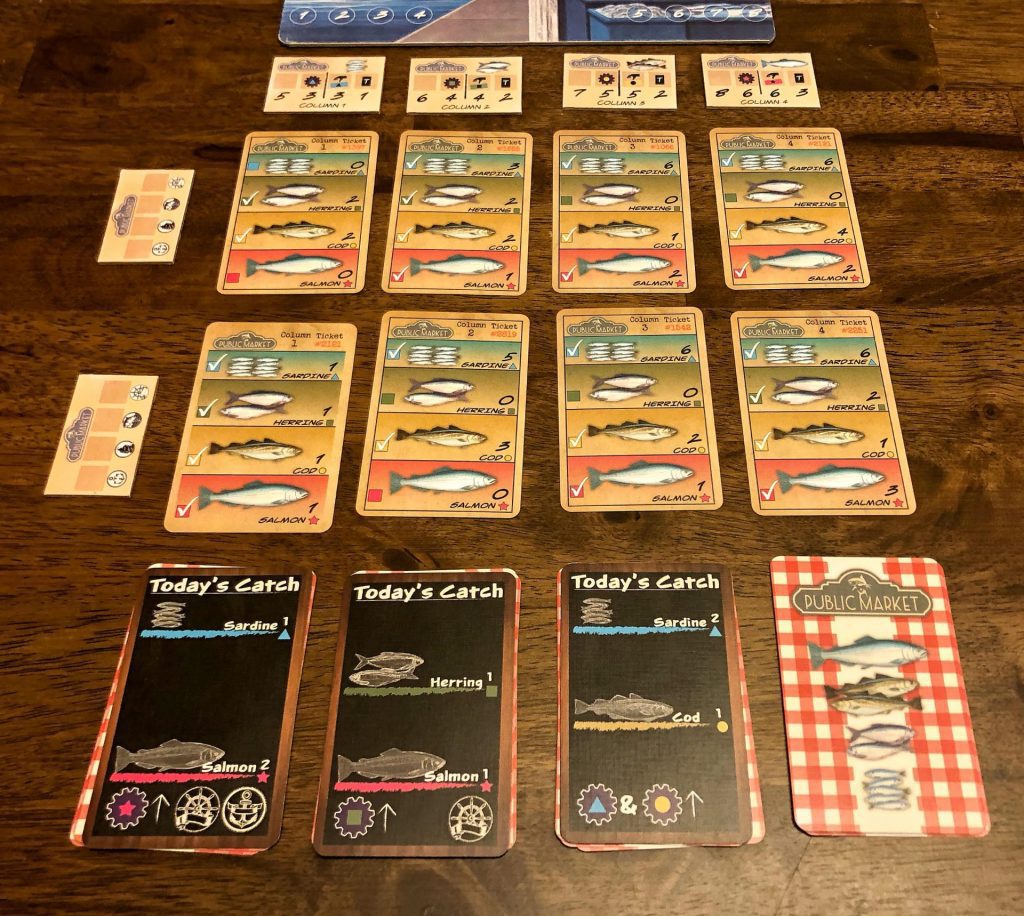
There are two types of contracts available to fulfill: Public Contracts and Today’s Catch. The former are repeatable and offer a variable reward; on completion, the player may place one of their scoring cubes on any of the reward squares associated with that contract’s row and column. The latter type of contract has a fixed reward and the card is taken by the player upon completion, opening up new options for successive players.
The variety of scoring possibilities here is staggering. Players may complete as many contracts as they wish provided they have the requisite fish, and with 12 contracts available at any time it can be painfully difficult to choose which ones to fill for which rewards. The squares associated with the Public Contracts offer different levels of raw victory points, sometimes alongside free fish or the option to claim a Today’s Catch card without paying any fish.
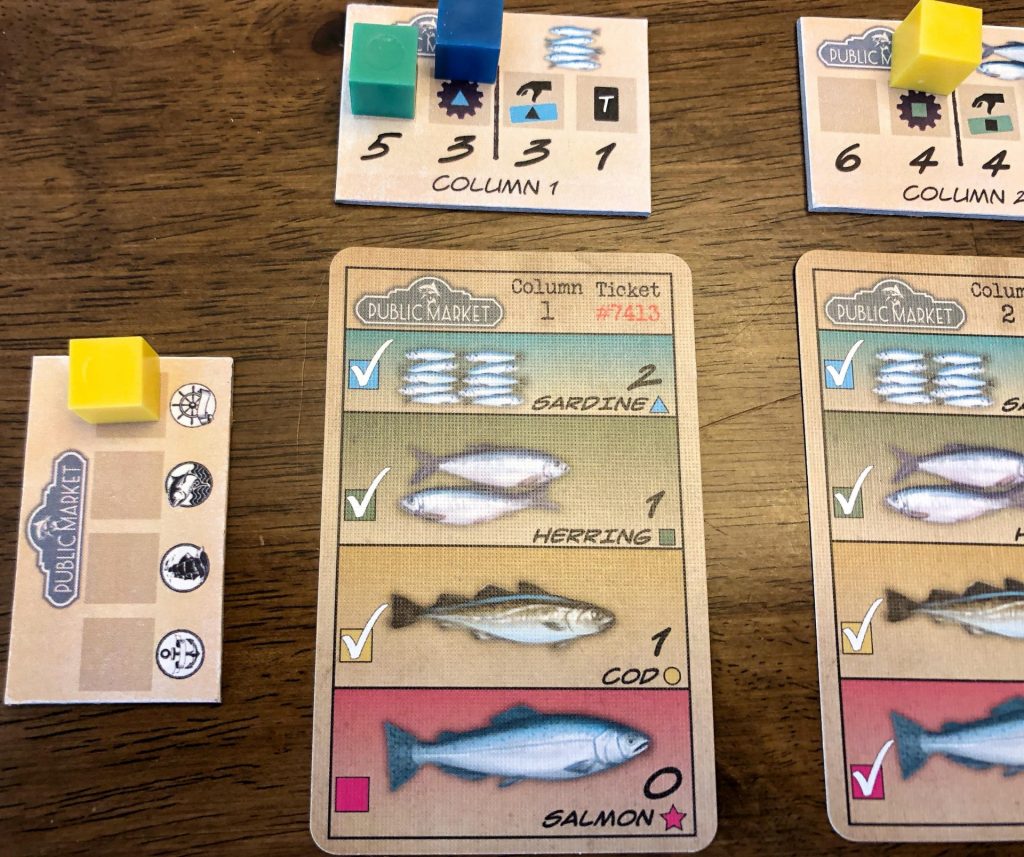
Both types of contract can also pay off in two powerful things: cannery logos and gears. The logos are an additional set collection option that score at the end of the game even if the sets aren’t fully complete, so they’re never entirely wasted. The gears add an engine-building element to the game with each gear of any fish type counting as a bonus fish of that type, enabling players to more easily complete large contracts and rack up major rewards over time.
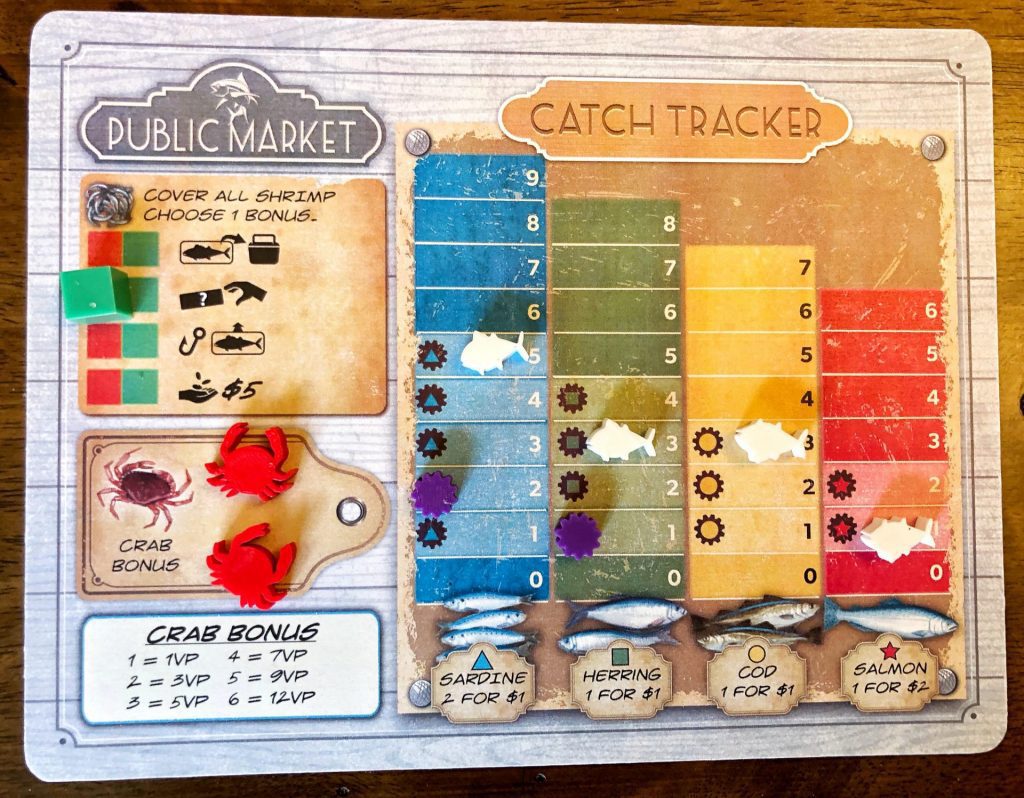
You may have noticed that none of the contracts pay in money. Once a player has finished filling contracts, any remaining fish in their ice chest are sold for spare cash. Players will also get $3 for each complete column or row (their choice) in the chest, so efficiency pays off here. Of course, efficient space usage and effective contract fulfillment can often be at loggerheads.
(Sitting on) The Dock of the Bay
The end of the game is triggered when there are no more fish tiles to be added to the ocean at the end of a round. However, play continues for a few more rounds after that checkpoint, leading to a desperate scramble to get the best of the remaining fish before that final sale. At the end of the game, players will get victory points for the reward squares they picked for completing Public Contracts as well as cash on hand, sets of crabs, and sets of cannery logos.

Point totals tend to be pretty tight, sometimes down to a single point. That’s both reassuring — because it suggests the game is well-balanced — and a little frustrating, as it occasionally feels like there isn’t really a meaningful strategic choice to make. You’ll still want to keep one eye on the horizon and adjust your course as needed, but overall Public Market is a game about making the most of each turn rather than crafting a grand plan and sticking to it. On deeper reflection, I think that’s probably a positive. If you’re the kind of player who enjoys solving an ever-changing efficiency puzzle, you’ll find plenty here to munch on.
Watching the Tide Rolling Away
In case you haven’t guessed, Public Market is a great game. It’s deep and thinky in all the best ways, a comfortingly hearty cioppino of familiar mechanisms served up in a new and surprising combination. Between last year’s Vinyl and Public Market, Talon Strikes Studios is finding their stride with games that have the mechanical meatiness of a well-made Euro and the buttery flavor of an entertaining theme.
If you want to pick up Public Market, check out the Kickstarter going on right now!


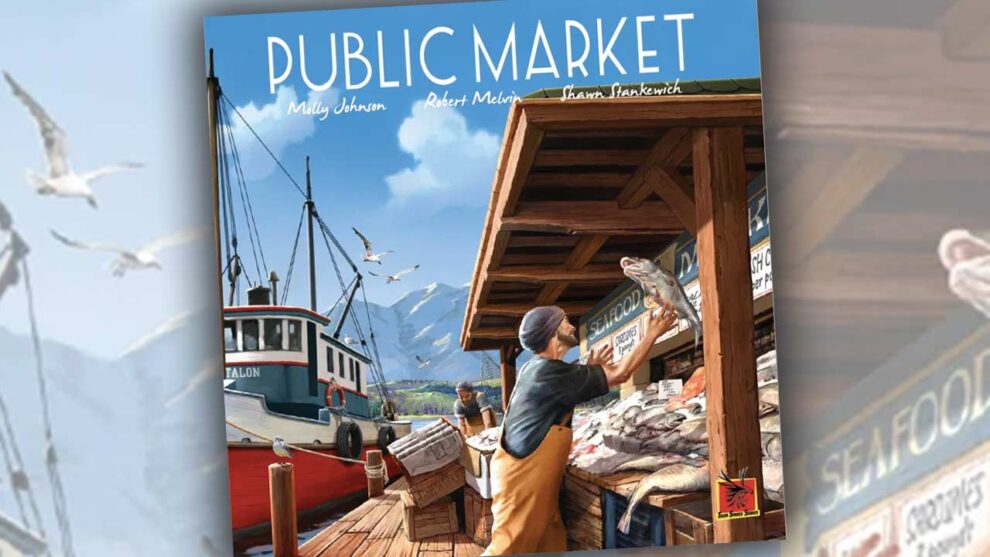









Add Comment